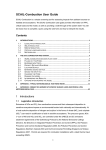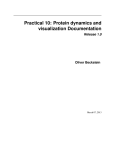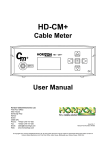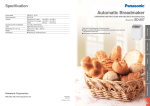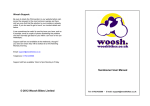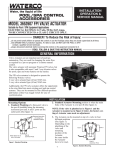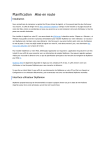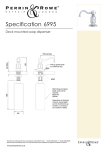Download 2006_02 Web
Transcript
Skywritings Page 8 Committee Contacts Co-ordinator: Jaqui Clark New Orchard Farm, Sittingbourne, ME9 0QL Tel & Fax: 01795 – 830378 E-mail: [email protected] Treasurer: John Dean 01892 822776 [email protected] Membership Secretary: Graham Hammond 01622 891466 [email protected] Newsletter Editor: Mike Negus 01634 364396 57 Ploughmans Way Rainham, Kent, ME8 8LH [email protected] Committee Members: Mark Balding 01959 523825 Brian Hope 01795 662508 Mike Tooze 01634 865516 Derek Browning 01622 736626 Bob Chequer 01634 668276 Stephen Solley 01304 374337 Norman Willoughby 01634 314739 Newsletter report by me reiterated Johns news on the printer and a request as always for articles and believe you me you would be surprised what I can create out of even a snippet of news so it can be a page a paragraph or a sentence ANY input welcome. I never let the facts get in the way of a good story as some of you might be cottoning on to. Mark gave a run down on events and in talks with some after the meeting we had some good ideas so watch this space. Despite an appeal for reason the committee in its present form was reinstated for another year after a request for new members ( which still applies ) and a vote of thanks given gratefully accepted. Finally any other business produced some interesting feedback which was duly noted and some of these ideas could well be adopted thereafter the meeting closed and the membership got on with what it does best - drinking and nattering! Have a bad toothache? Smash your thumb with a hammer and you will forget about the toothache Dates for your Diary February 23 March 30 April 27 Builders Evening Arctic by RV Talk on Weather www.midkentstrut.freeserve.co.uk Skywritings Page 1 February 2006 SKYWRITINGS Newsletter of the Mid Kent Strut of the Mike's Mutterings Mike Negus Editor FORCED LANDING No Problem ??? One of our Strut members, Les Powell, had the misfortune to be able to amply demonstrate his skill at a forced landing last October when part of his prop parted company. The following is his account of what happened. After a stop of an hour and a half at Sibsey and a fuel top up to maximum with MoGas, the aircraft was checked for flight and all seemed in order. There were no problems evident with the aircraft on the flight up to Lincolnshire from Kent, the previous morning: 09:40-11:00. bags were strapped on the parcel shelf behind the seats. The engine was hand propped and started normally; power check with chocks was performed including carburetor heat and magneto checks. The strip is orientated E-W and the windsock indicated No passengers were on that the prevailing wind was a gusty variable southboard, however 2 Flight erly. I elected to use the entire runway from the east www.midkentstrut.freeserve.co.uk Skywritings Page 2 and use as much diagonal run as possible. The aircraft was lined up after full and free controls was established, hatches, harness and engine power, the take off roll was not unusual considering the crosswind effect. On climb out I experienced moderate turbulence and intended to climb out to the south avoiding Boston up to 2000`. I contacted Conningsby Radar and advised them of my intentions; they asked me to squawk, which I couldn`t . Soon after I was advised to contact Marham Zone, this I did. I advised that I would be staying at 1700` and would be routing via Fenland. They advised me to contact Fenland then get back to them. Rather than contact Fenland as I have had difficulty raising them in the past on a Monday I climbed to 2000` then reported to Marham. They gave me a flight information service. Around five minutes past Fenland I felt a thud at the front and saw what I thought was a bird exiting the prop at the 2 o’clock position. I realized that something had happened to the power plant by the level of vibration, so I throttled back and at certain rpm that made it worse, I didn’t know how much the turning prop was aiding the descent so I elected to keep it running and minimize the vibration. I established that the aircraft was still flyable and turned Feb Meeting at the Golf Club — 23rd February Skywritings Page 7 down sun to get a better orientation of the fields and Dykes. I proceeded to call a Pan Pan and advised that I was making a precautionary landing on the Marham frequency ( I also heard an American voice in there somewhere) but I think my signal was getting weak as I descended, they didn’t know how many occupants there were. was a bit miserable as it has been all that month but were we downhearted , course not! Yours truly took the meeting after a fashion and the following is a report on the proceedings. I elected a field to land in which looked big and flat and into the wind, as soon as I crossed the threshold I cut the magnetos and rolled to halt. I tried to raise Marham Jaqui’s report was read out summarizing a fairly packed agenda for 2005 and confirmed her decision to stand down from the position of Strut Coordinator which she had held for a number of years. Fortunately she has decided to stay on as a committee member so we shall still have the benefit of her sparkling repartee and enthusiasm. A vote of thanks was expressed for her past service from the floor and we are delighted to record it here. Marham ATC Apologies for absence were given for Jaqui, Graham , Derek and Mike Tooze who had resigned his commission. Treasurers report was given by John which showed a healthy balance which had been reported through the last newsletter. Principal expense was the purchase of a printer on which to pro- duce the newsletter thus saving in the long run this expense whilst paying for itself over the next few months. John could report therefore no increase in subscriptions this year which compared with some other Struts is still modest thanks to Johns steady hand and prudent use of the Strut cheque book for which we should all be grateful. A brief update on membership in Grahams absence revealed a fairly static situation which probably has remained so these long years but new blood is still welcome. If you are choking on an ice cube, don’t panic. Simply pour a cup of boiling water down your throat and presto. The blockage will almost instantly be removed! but they didn’t respond then I transmitted blind to try and get a relay message through to say I was alright, but there were no aircraft in the vicinity on that frequency. I evacuated the aircraft to inspect the front and realized that half a blade of the prop was missing, this had caused the vibration. I contacted Steve Solley on his mobile phone and asked if he would speak to the RAF and say all was well as I had no contact number. I couldn’t raise Fenland by telephone (closed). I also gave him my position extracted from the GPS. Within a very short space of time I was visited by a www.midkentstrut.freeserve.co.uk www.midkentstrut.freeserve.co.uk Skywritings Page 6 found the best way to find intermittent problems with the speakers on the headset was to connect the suspect unit to another headset using an intercom, then wiggling the wires and bits on the suspect headset while wearing it and listening for crackles or dead spots. Intermittent microphone problems on the suspect headset can be made in the same way but this time wearing the “good” headset. Call me if you need any help! Transmitted voice quality – a very large and subjective topic, as no two people will normally have the same opinion when comparing audio quality. Because communication components do not always match up perfectly with one another, it is “my” opinion that you should listen on the ground to someone else using your aircrafts communication system including your personal headset with the engine running. This will allow you to hear what it actually sounds like to other radio users, which can be a lot different, to that experienced by you onboard your own aircraft through the intercom. If an intercom unit is fitted try plugging the headset directly into the radio and repeat the test to see if this is causing problems. When possible, use someone else’s kit in your aircraft and yours in theirs for comparison. If the problem moves with your kit and disappears using theirs then you have probably identified the cause. It may then be necessary if a poor voice quality problem has been identified to make, when possible, level adjustments to the microphone. If clipping and/or distortion is heard it may be the microphone gain is too high or too low if the audio is faint. Microphones can degrade slowly and do go wrong. Be warned - even if you can get a replacement part they are not normally cheap. If there is a com- patibility issue then the more expensive option is to find an alternative type, make of headset or equipment that works with your aircraft - and that is your choice! Received voice quality – I tune to a station like VOLMET to test the headset speakers; the quality of this station is reasonably constant as it uses pre-recorded messages. Plugging them directly into the radio can easily test headset speakers. Try a different radio if the problem persists to check if it is your headset or the radio that is at fault. Note that speakers, like microphones, can slowly degrade and you can get used to it over a period of time! Typical problem that I come across are the intercom battery being low and the squelch and audio level are not set correctly for flight conditions. Another common “fault” is the mono/stereo switch being set to stereo causing only one speaker to work. A problem that I am guilty of is to somehow set the headsets own built in volume control to off or low and compensate for this by blasting it from either the intercom or the radio. I am happy to offer advice or hands on help if needed. My e-mail is [email protected] Mobile 0774 028 3297. (Please note that there is actually a _ between john & knight) AGM Thursday 26th January 2006 Weather was I would like to believe affecting the turnout for the above, it www.midkentstrut.freeserve.co.uk Skywritings Page 3 Tornado Jet and I walked around the aircraft facing them to indicate my state of health. Spring Radio Checks by John Knight Spring is not that far away and I have jotted a few notes on some basic checks that can be made to your radio equipment especially if it has not been used during the winter. This article has been written only as a general guide and some of it may not be applicable to the type of radio or the rest of the equipment installed in your aircraft. It is generally biased towards handheld models like the I Cambridgeshire Police Helicopter Shortly afterwards I was visited by the Cambridgeshire Police Helicopter who were out anyway, they took my details. I was also visited by the Police Armed response unit, and two Fire appliances, one from each end of the road I was adjacent to. I found out the owners of the field and they were contacted and advised of the situation, they were not unduly worried and came along about two hours later to see what had happened. Richard Yates, Licensed Engineer, came to the site to fit a replacement propeller and do machinery checks to establish serviceability of the aircraft. After numerous ground power runs I felt there was nothing abnormal in the way of vibration, I then elected to continue on my way after a couple of circuits in the overhead. He makes it sound so easy, doesn’t he? Don’t forget the Builders Evening— Strut members relate their stories at the February meeting. Icom IC-A22 Icom IC-A22 that I own and also seems to be popular with a lot Strut members. Please contact me if you have questions about other types of transceivers and I will try and help if I can. www.midkentstrut.freeserve.co.uk Skywritings Page 4 Handheld Transceiver Batteries These are particularly vulnerable to damage especially after a long winter of being left unused in your flight bag! Make sure that the battery is almost completely discharged through normal use before fully charging it for the time specified in the user manual, Icom manuals can be downloaded from http://www.icom.co.jp/world/support /download/manual.html if needed. Damage can occur to the battery pack if it is allowed to go “completely” flat for extended periods of time or if it is overcharged. They also suffer from “memory” effects leading to shorter battery operational time if they are not fully discharged and then recharged for the correct time. A lot of pilots use the aircrafts own electrical power to externally supply the radio. This has the advantage of not loosing communications due to the battery going flat but the down side is that, as with my own IC-A22, the transceiver battery is also being charged at the same time leading to possible memory effects or overcharging. A way to get round this is to remove the Ni-Cad battery pack and run the transceiver directly from the aircraft. This leaves the bottom of the body of the transceiver exposed, also a little short, and an empty alkaline battery case may be fitted to overcome this. Many aircraft voltage regulators are not very good at stopping transient voltage spikes (especially when starting/stopping the engine), please be aware of this, and if possible have the radio turned off at these times. If the battery life becomes extremely short then it is time buy a replacement and dispose of the old one in a responsible way. SWR Meter Antenna The SWR, or Standing Wave Ratio, of an antenna is a measure of how efficiently your radio is radiating the energy it produces when you transmit. Transmitting (more than 1-2sec for test purposes) without an antenna connected or with an antenna grossly out of tune could damage the radio. The energy produced by the radio, when in transmit mode, needs to radiate (and hence dissipate heat). If it is unable to do so (for whatever reason) it will be reflected back into the radio and damage the PA (Power Amplifier) unit. Skywritings Page 5 perform as well as a properly fitted external unit! Note! DO NOT transmit without an antenna f i t t e d ! DO NOT transmit without an antenna designed for air-band frequencies. DO NOT transmit with a damaged f e e d e r c a b l e . DO NOT transmit with a disconnected f e e d e r c a b l e DO NOT transmit with the antenna is grossly out of tune i.e. SWR greater than 3:1 Here are some simple checks that test the basic continuity of the antenna fitted to an aircraft. Disconnect the radio and check with a multi-meter set to measure resistance that there are good electrical contacts (continuity or zero resistance) between the outside (ground) screen of the BNC connector and the metal body of the aircraft or each of the ground plane foil strips if fitted to a non-metallic aircraft. There is a good electrical contact (continuity or zero resistance) between the centre pin of the BNC plug and the stainless-steel whip. There is no electrical contact (open circuit or infinite resistance) between the screen of the BNC and the centre pin. Headsets I have the equipment to make SWR measurements but the aircrafts transmitter must have at least 10W output, most handhelds claim to put out only 5W, for it to work and it may be necessary to “borrow” a radio with this higher power output to do this test. Please note that a “rubber duck” or the type of antenna fitted to windscreens does not www.midkentstrut.freeserve.co.uk These frequently seem to cause problems and it is sometimes difficult to identify the source of a fault. It is very import to use the correct accessories on all radios to maintain performance and prevent damage. For example the IC-A22E has a cloning facility and the connection to this data line is on the “ring” of the stereo headset socket. Plugging a headset or a converter with mono jack plug fitted will cause the data line to be earthed and possibly damage the unit. Typical faults are – Dirty connections - my personal way of solving this, when conditions allow, is to use Maplins Switch Cleaner or something similar, and a clean piece of dry cotton cloth, or just a piece of dry cotton cloth on its own. Some people recommend wire wool but I think using it can do more damage and reduce the working life of the connectors, especially the chrome types. Wiring problems – they seem to crop up in most places on headsets as well as aircraft. The faults are typically found where the cable enters the headset or connectors and can be intermittent in nature making problems hard to find. If you are confident with electrical items finding broken wires or open circuit components is a simple matter of using a multi-meter set on the resistance range. I www.midkentstrut.freeserve.co.uk Skywritings Page 4 Handheld Transceiver Batteries These are particularly vulnerable to damage especially after a long winter of being left unused in your flight bag! Make sure that the battery is almost completely discharged through normal use before fully charging it for the time specified in the user manual, Icom manuals can be downloaded from http://www.icom.co.jp/world/support /download/manual.html if needed. Damage can occur to the battery pack if it is allowed to go “completely” flat for extended periods of time or if it is overcharged. They also suffer from “memory” effects leading to shorter battery operational time if they are not fully discharged and then recharged for the correct time. A lot of pilots use the aircrafts own electrical power to externally supply the radio. This has the advantage of not loosing communications due to the battery going flat but the down side is that, as with my own IC-A22, the transceiver battery is also being charged at the same time leading to possible memory effects or overcharging. A way to get round this is to remove the Ni-Cad battery pack and run the transceiver directly from the aircraft. This leaves the bottom of the body of the transceiver exposed, also a little short, and an empty alkaline battery case may be fitted to overcome this. Many aircraft voltage regulators are not very good at stopping transient voltage spikes (especially when starting/stopping the engine), please be aware of this, and if possible have the radio turned off at these times. If the battery life becomes extremely short then it is time buy a replacement and dispose of the old one in a responsible way. SWR Meter Antenna The SWR, or Standing Wave Ratio, of an antenna is a measure of how efficiently your radio is radiating the energy it produces when you transmit. Transmitting (more than 1-2sec for test purposes) without an antenna connected or with an antenna grossly out of tune could damage the radio. The energy produced by the radio, when in transmit mode, needs to radiate (and hence dissipate heat). If it is unable to do so (for whatever reason) it will be reflected back into the radio and damage the PA (Power Amplifier) unit. Skywritings Page 5 perform as well as a properly fitted external unit! Note! DO NOT transmit without an antenna f i t t e d ! DO NOT transmit without an antenna designed for air-band frequencies. DO NOT transmit with a damaged f e e d e r c a b l e . DO NOT transmit with a disconnected f e e d e r c a b l e DO NOT transmit with the antenna is grossly out of tune i.e. SWR greater than 3:1 Here are some simple checks that test the basic continuity of the antenna fitted to an aircraft. Disconnect the radio and check with a multi-meter set to measure resistance that there are good electrical contacts (continuity or zero resistance) between the outside (ground) screen of the BNC connector and the metal body of the aircraft or each of the ground plane foil strips if fitted to a non-metallic aircraft. There is a good electrical contact (continuity or zero resistance) between the centre pin of the BNC plug and the stainless-steel whip. There is no electrical contact (open circuit or infinite resistance) between the screen of the BNC and the centre pin. Headsets I have the equipment to make SWR measurements but the aircrafts transmitter must have at least 10W output, most handhelds claim to put out only 5W, for it to work and it may be necessary to “borrow” a radio with this higher power output to do this test. Please note that a “rubber duck” or the type of antenna fitted to windscreens does not www.midkentstrut.freeserve.co.uk These frequently seem to cause problems and it is sometimes difficult to identify the source of a fault. It is very import to use the correct accessories on all radios to maintain performance and prevent damage. For example the IC-A22E has a cloning facility and the connection to this data line is on the “ring” of the stereo headset socket. Plugging a headset or a converter with mono jack plug fitted will cause the data line to be earthed and possibly damage the unit. Typical faults are – Dirty connections - my personal way of solving this, when conditions allow, is to use Maplins Switch Cleaner or something similar, and a clean piece of dry cotton cloth, or just a piece of dry cotton cloth on its own. Some people recommend wire wool but I think using it can do more damage and reduce the working life of the connectors, especially the chrome types. Wiring problems – they seem to crop up in most places on headsets as well as aircraft. The faults are typically found where the cable enters the headset or connectors and can be intermittent in nature making problems hard to find. If you are confident with electrical items finding broken wires or open circuit components is a simple matter of using a multi-meter set on the resistance range. I www.midkentstrut.freeserve.co.uk Skywritings Page 6 found the best way to find intermittent problems with the speakers on the headset was to connect the suspect unit to another headset using an intercom, then wiggling the wires and bits on the suspect headset while wearing it and listening for crackles or dead spots. Intermittent microphone problems on the suspect headset can be made in the same way but this time wearing the “good” headset. Call me if you need any help! Transmitted voice quality – a very large and subjective topic, as no two people will normally have the same opinion when comparing audio quality. Because communication components do not always match up perfectly with one another, it is “my” opinion that you should listen on the ground to someone else using your aircrafts communication system including your personal headset with the engine running. This will allow you to hear what it actually sounds like to other radio users, which can be a lot different, to that experienced by you onboard your own aircraft through the intercom. If an intercom unit is fitted try plugging the headset directly into the radio and repeat the test to see if this is causing problems. When possible, use someone else’s kit in your aircraft and yours in theirs for comparison. If the problem moves with your kit and disappears using theirs then you have probably identified the cause. It may then be necessary if a poor voice quality problem has been identified to make, when possible, level adjustments to the microphone. If clipping and/or distortion is heard it may be the microphone gain is too high or too low if the audio is faint. Microphones can degrade slowly and do go wrong. Be warned - even if you can get a replacement part they are not normally cheap. If there is a com- patibility issue then the more expensive option is to find an alternative type, make of headset or equipment that works with your aircraft - and that is your choice! Received voice quality – I tune to a station like VOLMET to test the headset speakers; the quality of this station is reasonably constant as it uses pre-recorded messages. Plugging them directly into the radio can easily test headset speakers. Try a different radio if the problem persists to check if it is your headset or the radio that is at fault. Note that speakers, like microphones, can slowly degrade and you can get used to it over a period of time! Typical problem that I come across are the intercom battery being low and the squelch and audio level are not set correctly for flight conditions. Another common “fault” is the mono/stereo switch being set to stereo causing only one speaker to work. A problem that I am guilty of is to somehow set the headsets own built in volume control to off or low and compensate for this by blasting it from either the intercom or the radio. I am happy to offer advice or hands on help if needed. My e-mail is [email protected] Mobile 0774 028 3297. (Please note that there is actually a _ between john & knight) AGM Thursday 26th January 2006 Weather was I would like to believe affecting the turnout for the above, it www.midkentstrut.freeserve.co.uk Skywritings Page 3 Tornado Jet and I walked around the aircraft facing them to indicate my state of health. Spring Radio Checks by John Knight Spring is not that far away and I have jotted a few notes on some basic checks that can be made to your radio equipment especially if it has not been used during the winter. This article has been written only as a general guide and some of it may not be applicable to the type of radio or the rest of the equipment installed in your aircraft. It is generally biased towards handheld models like the I Cambridgeshire Police Helicopter Shortly afterwards I was visited by the Cambridgeshire Police Helicopter who were out anyway, they took my details. I was also visited by the Police Armed response unit, and two Fire appliances, one from each end of the road I was adjacent to. I found out the owners of the field and they were contacted and advised of the situation, they were not unduly worried and came along about two hours later to see what had happened. Richard Yates, Licensed Engineer, came to the site to fit a replacement propeller and do machinery checks to establish serviceability of the aircraft. After numerous ground power runs I felt there was nothing abnormal in the way of vibration, I then elected to continue on my way after a couple of circuits in the overhead. He makes it sound so easy, doesn’t he? Don’t forget the Builders Evening— Strut members relate their stories at the February meeting. Icom IC-A22 Icom IC-A22 that I own and also seems to be popular with a lot Strut members. Please contact me if you have questions about other types of transceivers and I will try and help if I can. www.midkentstrut.freeserve.co.uk Skywritings Page 2 and use as much diagonal run as possible. The aircraft was lined up after full and free controls was established, hatches, harness and engine power, the take off roll was not unusual considering the crosswind effect. On climb out I experienced moderate turbulence and intended to climb out to the south avoiding Boston up to 2000`. I contacted Conningsby Radar and advised them of my intentions; they asked me to squawk, which I couldn`t . Soon after I was advised to contact Marham Zone, this I did. I advised that I would be staying at 1700` and would be routing via Fenland. They advised me to contact Fenland then get back to them. Rather than contact Fenland as I have had difficulty raising them in the past on a Monday I climbed to 2000` then reported to Marham. They gave me a flight information service. Around five minutes past Fenland I felt a thud at the front and saw what I thought was a bird exiting the prop at the 2 o’clock position. I realized that something had happened to the power plant by the level of vibration, so I throttled back and at certain rpm that made it worse, I didn’t know how much the turning prop was aiding the descent so I elected to keep it running and minimize the vibration. I established that the aircraft was still flyable and turned Feb Meeting at the Golf Club — 23rd February Skywritings Page 7 down sun to get a better orientation of the fields and Dykes. I proceeded to call a Pan Pan and advised that I was making a precautionary landing on the Marham frequency ( I also heard an American voice in there somewhere) but I think my signal was getting weak as I descended, they didn’t know how many occupants there were. was a bit miserable as it has been all that month but were we downhearted , course not! Yours truly took the meeting after a fashion and the following is a report on the proceedings. I elected a field to land in which looked big and flat and into the wind, as soon as I crossed the threshold I cut the magnetos and rolled to halt. I tried to raise Marham Jaqui’s report was read out summarizing a fairly packed agenda for 2005 and confirmed her decision to stand down from the position of Strut Coordinator which she had held for a number of years. Fortunately she has decided to stay on as a committee member so we shall still have the benefit of her sparkling repartee and enthusiasm. A vote of thanks was expressed for her past service from the floor and we are delighted to record it here. Marham ATC Apologies for absence were given for Jaqui, Graham , Derek and Mike Tooze who had resigned his commission. Treasurers report was given by John which showed a healthy balance which had been reported through the last newsletter. Principal expense was the purchase of a printer on which to pro- duce the newsletter thus saving in the long run this expense whilst paying for itself over the next few months. John could report therefore no increase in subscriptions this year which compared with some other Struts is still modest thanks to Johns steady hand and prudent use of the Strut cheque book for which we should all be grateful. A brief update on membership in Grahams absence revealed a fairly static situation which probably has remained so these long years but new blood is still welcome. If you are choking on an ice cube, don’t panic. Simply pour a cup of boiling water down your throat and presto. The blockage will almost instantly be removed! but they didn’t respond then I transmitted blind to try and get a relay message through to say I was alright, but there were no aircraft in the vicinity on that frequency. I evacuated the aircraft to inspect the front and realized that half a blade of the prop was missing, this had caused the vibration. I contacted Steve Solley on his mobile phone and asked if he would speak to the RAF and say all was well as I had no contact number. I couldn’t raise Fenland by telephone (closed). I also gave him my position extracted from the GPS. Within a very short space of time I was visited by a www.midkentstrut.freeserve.co.uk www.midkentstrut.freeserve.co.uk Skywritings Page 8 Committee Contacts Co-ordinator: Jaqui Clark New Orchard Farm, Sittingbourne, ME9 0QL Tel & Fax: 01795 – 830378 E-mail: [email protected] Treasurer: John Dean 01892 822776 [email protected] Membership Secretary: Graham Hammond 01622 891466 [email protected] Newsletter Editor: Mike Negus 01634 364396 57 Ploughmans Way Rainham, Kent, ME8 8LH [email protected] Committee Members: Mark Balding 01959 523825 Brian Hope 01795 662508 Mike Tooze 01634 865516 Derek Browning 01622 736626 Bob Chequer 01634 668276 Stephen Solley 01304 374337 Norman Willoughby 01634 314739 Newsletter report by me reiterated Johns news on the printer and a request as always for articles and believe you me you would be surprised what I can create out of even a snippet of news so it can be a page a paragraph or a sentence ANY input welcome. I never let the facts get in the way of a good story as some of you might be cottoning on to. Mark gave a run down on events and in talks with some after the meeting we had some good ideas so watch this space. Despite an appeal for reason the committee in its present form was reinstated for another year after a request for new members ( which still applies ) and a vote of thanks given gratefully accepted. Finally any other business produced some interesting feedback which was duly noted and some of these ideas could well be adopted thereafter the meeting closed and the membership got on with what it does best - drinking and nattering! Have a bad toothache? Smash your thumb with a hammer and you will forget about the toothache Dates for your Diary February 23 March 30 April 27 Builders Evening Arctic by RV Talk on Weather www.midkentstrut.freeserve.co.uk Skywritings Page 1 February 2006 SKYWRITINGS Newsletter of the Mid Kent Strut of the Mike's Mutterings Mike Negus Editor FORCED LANDING No Problem ??? One of our Strut members, Les Powell, had the misfortune to be able to amply demonstrate his skill at a forced landing last October when part of his prop parted company. The following is his account of what happened. After a stop of an hour and a half at Sibsey and a fuel top up to maximum with MoGas, the aircraft was checked for flight and all seemed in order. There were no problems evident with the aircraft on the flight up to Lincolnshire from Kent, the previous morning: 09:40-11:00. bags were strapped on the parcel shelf behind the seats. The engine was hand propped and started normally; power check with chocks was performed including carburetor heat and magneto checks. The strip is orientated E-W and the windsock indicated No passengers were on that the prevailing wind was a gusty variable southboard, however 2 Flight erly. I elected to use the entire runway from the east www.midkentstrut.freeserve.co.uk








